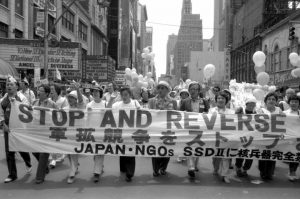Nihon Hidankyo’s path to Nobel Peace Prize, Part 5: A-bomb survivors make appeals internationally, striking chord with people in the West
Dec. 5, 2024
Sight of survivors confronting hardship moved hearts
by Fumiyasu Miyano, Staff Writer
“Please look at my face and my hands. Look at them carefully please,” said Senji Yamaguchi, co-chair of the Japan Confederation of A- and H-Bomb Sufferers Organizations (Nihon Hidankyo) who died in 2013. Mr. Yamaguchi was speaking at the second United Nations Special Session on Disarmament in June 1982, as the first hibakusha (A-bomb survivor) to do so. He reported how he had suffered severe burns on his upper body in the atomic bombing and had been hospitalized for seven months. He also spoke of how he had seen a mother holding a nearly decapitated baby. In front of representatives from U.N. member nations, he cried out an appeal about the inhumanity of nuclear weapons.
During his speech, Mr. Yamaguchi held up a photograph in his right hand of his own keloid scars. The photo was from a page in “HIBAKUSHA,” a brochure that had been produced by the Hidankyo organization. The brochure’s contents were in three languages—Japanese, English, and German—and prior to the special session, 100,000 copies had been printed. Mr. Yamaguchi concluded his remarks with the words, “No more war, no more hibakusha,” which became the symbol of the group’s international activities.
Nuclear war becoming more real
At that time, Nihon Hidankyo sent 41 delegates to the United Nations. According to Fumiko Nishizaki, 65, professor emeritus at the University of Tokyo who joined the delegation as an interpreter, Mr. Yamaguchi was not feeling well on the visit. He therefore refrained from participating in such events as the “Million-person demonstration” and other gatherings in order to prepare for his remarks. Ms. Nishizaki said, “I felt he had the power of someone who had something to intently communicate.”
Starting in the late 1970s, Nihon Hidankyo’s call began to resonate with anti-nuclear movements taking place in Western nations. In the midst of the Cold War, people feared that nuclear war was becoming more likely. The deployment of nuclear missiles in Europe by the United States and the Soviet Union triggered the spread of the slogan “No Euroshima” (meaning that Europe should not be turned into a nuclear battlefield like Hiroshima). Nihon Hidankyo was active in handling requests from European nations to send A-bomb survivors there.
In August 1982, a delegation led by Sakae Ito, co-chair of Nihon Hidankyo who later served as chair of Hiroshima Hidankyo and died in 2000, went on a speaking tour of European nations. Satoru Konishi, head of the organization’s international division and a Hiroshima A-bomb survivor who died in 2015, participated in a gathering of a reported 500,000 people in Bonn, the capital of West Germany. At the gathering, the Sankichi Toge poem “Ningen wo Kaese” (in English, ‘Bring back the humans’) was read aloud in German. Mr. Konishi sent a report about his experience in the event to supporters in Japan, writing, “The enthusiasm and excitement of participants were overwhelming, a situation I can’t imagine in Japan.”
Tragedy of that day drove her action
Reiko Yamada, 90, a director of Toyukai, an A-bomb survivors’ association in Tokyo, who experienced the atomic bombing in Hiroshima, joined the Nihon Hidankyo speaking tour in October 1985, visiting the United Kingdom and France. After the tour, Ms. Yamada repeatedly visited the Soviet Union and the United States a total of 23 times through 2017. The tragedy she witnessed on August 6, 1945, drove her to act. “Many of the victims had been cremated even before their names were known. I want to communicate my memory of that time to ensure that no other hibakusha are ever created.”
Not only Nihon Hidankyo but other government agencies and private organizations based mainly in Hiroshima and Nagasaki also sent survivors overseas. Their countless testimonies planted the seeds for the “nuclear taboo,” a norm that stigmatizes nuclear weapons and advocates that the weapons should never be used again, in the minds of people around the world.
Alexander Kmentt, 59, director of the Disarmament Department at the Foreign Affairs Ministry of Austria, a nation that consistently advocates anti-nuclear policies, shared his perspective. “The A-bomb survivors underpinned the discussions in the 1980s, a time when people feared nuclear war and the nuclear arms race.” Guido Grunewald, 72, a member of an anti-war group in Germany that welcomed Mr. Konishi and others during their visit, said, “Rather than simply remaining victims, the survivors’ determination to confront their own hardship and carve out their lives without giving up deeply moved the hearts of others.”
To the Review Conference of the Parties to the Treaty on the Non-Proliferation of Nuclear Weapons (NPT) held in 2010 and 2015, Nihon Hidankyo sent delegations of around 50 people to the United States. To the review conference held in 2022, four people were dispatched. The average age of A-bomb survivors now exceeds 85 years. Grass-roots anti-nuclear campaigns around the world stand at a crossroads.
(Originally published on December 5, 2024)








